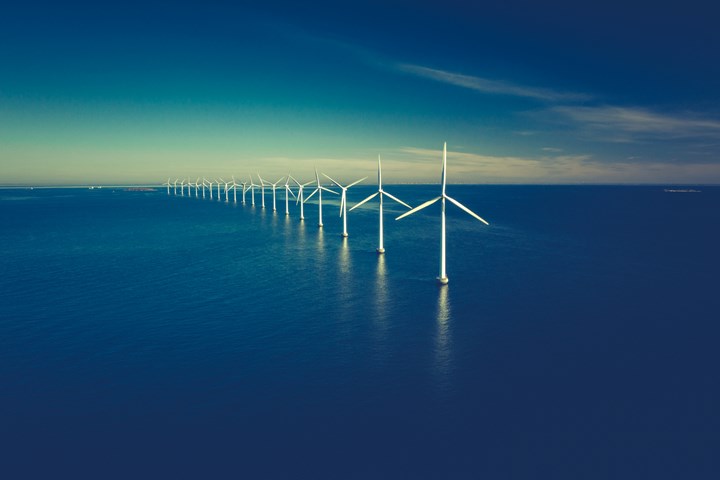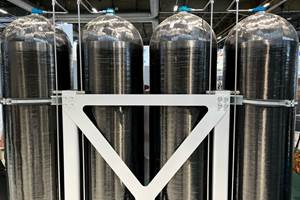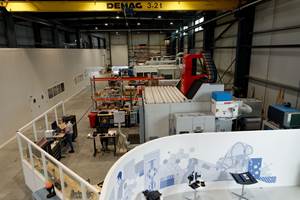Vestas unveils circularity solution to end landfill for turbine blades
A novel chemical process, developed within the CETEC initiative with partners Olin and Stena Recycling, is capable of breaking down epoxy resin to virgin-grade material.
Share
Read Next
Vestas Wind Systems A/S (Aarhus, Denmark) is presenting a new solution that renders epoxy-based wind turbine blades as circular, without the need for changing the design or composition of the blade material. Combining newly discovered chemical technology developed within the CETEC initiative, and partnerships with Olin (Clayton, Mo., U.S.) and Stena Recycling (Frogner, Norway), the solution can be applied to blades currently in operation. Once matured, Vestas says this will eliminate the need for blade redesign, or landfill disposal of epoxy-based blades when they are decommissioned.
“Until now, the wind industry has believed that turbine blade material calls for a new approach to design and manufacture to be either recyclable, or beyond this, circular, at end of life,” Lisa Ekstrand, vice president and head of sustainability at Vestas, says. “Going forward, we can now view old epoxy-based blades as a source of raw material. Once this new technology is implemented at scale, legacy blade material currently sitting in landfill, as well as blade material in active wind farms, can be disassembled, and reused. This signals a new era for the wind industry, and accelerates our journey towards achieving circularity.”
Turbine blades have previously been challenging to recycle due to the chemical properties of epoxy resin, a resilient substance that was believed to be impossible to break down into reusable components. This has led to many technology leaders attempting to replace or modify epoxy resin with alternatives that can be more easily treated. Vestas’ solution is enabled by a novel chemical process that can chemically break down epoxy resin into virgin-grade materials. The chemical process was developed in collaboration with Aarhus University (Denmark), Danish Technological Institute (Taastrup) and Olin the partners of the CETEC project, a coalition of industry and academia established to investigate circular technology for turbine blades.
“The newly discovered chemical process shows that epoxy-based turbine blades, whether in operation or sitting in landfill, can be turned into a source of raw material to potentially build new turbine blades,” Mie Elholm Birkbak, specialist, innovation and concepts at Vestas, adds. “As the chemical process relies on widely available chemicals, it is highly compatible for industrialization, and can therefore be scaled up quickly.”
WindEurope expects around 25,000 tonnes of blades to reach the end of their operational life annually by 2025.
Through a newly established value chain, supported by Nordic recycling company Stena Recycling and global epoxy manufacturer Olin, Vestas will now focus on scaling up the novel chemical disassembly process into a commercial solution. Once mature, the solution will signal the beginning of a circular economy for all existing, and future epoxy-based turbine blades.
For several decades, producing wind turbine blades manufactured with epoxy-based resin has been standard practice in the wind industry. In the most mature markets for wind energy, the first turbines are reaching the end of their operational life and this will increase over the coming years.
In addition, the new solution will provide Vestas with the opportunity to produce new turbine blades made from reused blade material. In the future, the new solution also signals the possibility to make all epoxy-based composite material a source of raw material for a broader circular economy, potentially encompassing industries beyond wind energy.
Related Content
Recycling hydrogen tanks to produce automotive structural components
Voith Composites and partners develop recycling solutions for hydrogen storage tanks and manufacturing methods to produce automotive parts from the recycled materials.
Read MoreASCEND program update: Designing next-gen, high-rate auto and aerospace composites
GKN Aerospace, McLaren Automotive and U.K.-based partners share goals and progress aiming at high-rate, Industry 4.0-enabled, sustainable materials and processes.
Read MorePlant tour: Arris Composites, Berkeley, Calif., U.S.
The creator of Additive Molding is leveraging automation and thermoplastics to provide high-volume, high-quality, sustainable composites manufacturing services.
Read MorePlant tour: Daher Shap’in TechCenter and composites production plant, Saint-Aignan-de-Grandlieu, France
Co-located R&D and production advance OOA thermosets, thermoplastics, welding, recycling and digital technologies for faster processing and certification of lighter, more sustainable composites.
Read MoreRead Next
Continuum targets facility capacity, transforms composite materials to advance wind blade recycling
The Denmark company details a CO2-neutral transformation technology to make 100% recyclable wind blades, plans to build six recycling facilities.
Read MoreSwancor, Siemens Gamesa collaborate on advancing recyclable wind blade technologies
Through Swancor’s recyclable thermosetting resin technologies, the recyclable resin and composites can be reused, assisting Siemens Gamesa in moving towards its goal of providing fully recyclable wind turbines in Taiwan.
Read MoreAll-recycled, needle-punched nonwoven CFRP slashes carbon footprint of Formula 2 seat
Dallara and Tenowo collaborate to produce a race-ready Formula 2 seat using recycled carbon fiber, reducing CO2 emissions by 97.5% compared to virgin materials.
Read More

















.jpg;maxWidth=300;quality=90)









